The Cambridge History of China. Vol. 13: Republican China 1912-1949, Part 2
Подождите немного. Документ загружается.

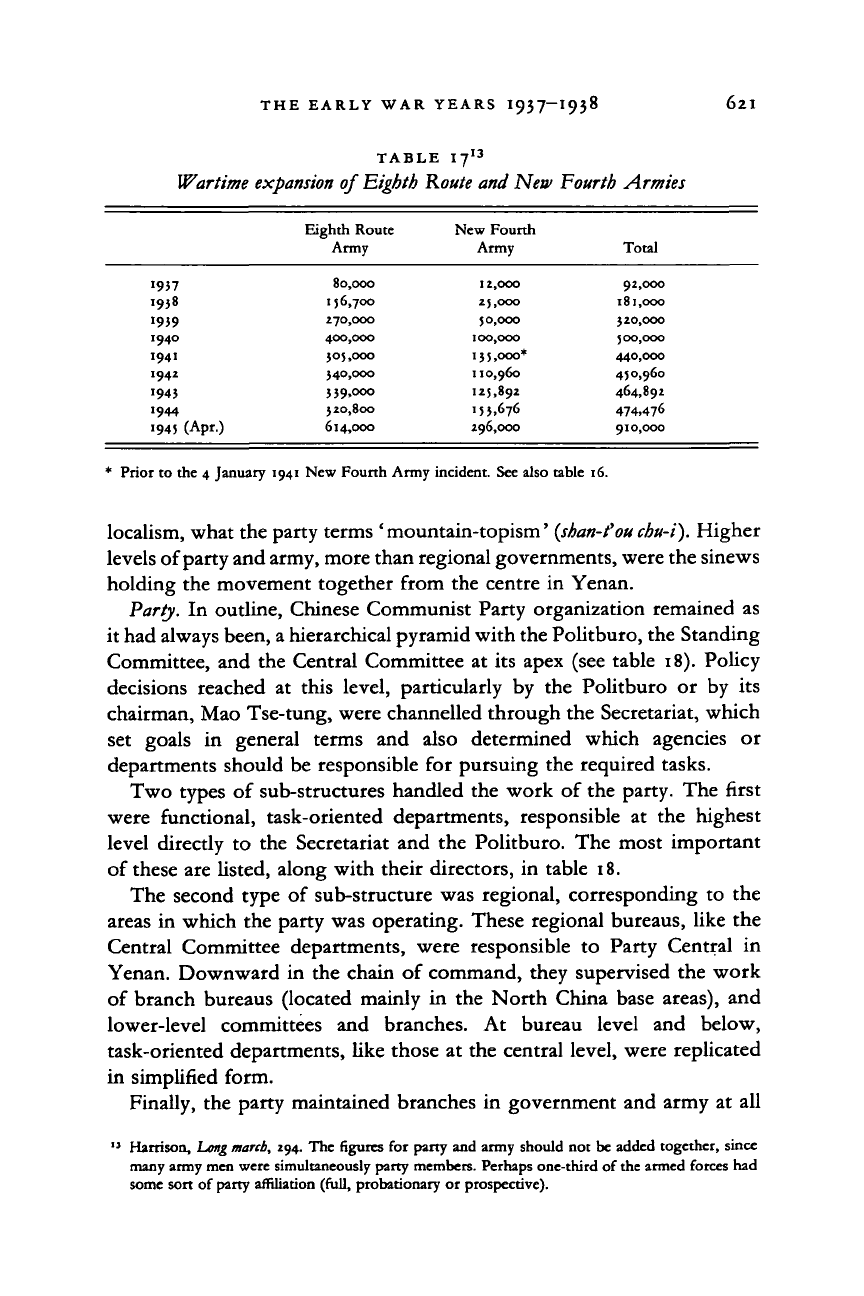
THE EARLY WAR YEARS I937—1938 6ll
TABLE I7
13
Wartime expansion of Eighth Route and New Fourth Armies
'937
1938
'959
1940
1941
1942
•943
1944
'945 (Apr.)
Eighth Route
Army
80,000
156,700
270,000
400,000
305,000
340,000
359,000
320,800
614,000
New Fourth
Army
12,000
25,000
50,000
100,000
135,000*
110,960
125,892
153,676
296,000
Total
92,000
181,000
320,000
500,000
440,000
450,960
464,892
474,476
910,000
* Prior to the 4 January 1941 New Fourth Army incident. See also table 16.
localism, what the party terms ' mountain-topism'
(shan-fou
chu-i).
Higher
levels of party and army, more than regional governments, were the sinews
holding the movement together from the centre in Yenan.
Party. In outline, Chinese Communist Party organization remained as
it had always been, a hierarchical pyramid with the Politburo, the Standing
Committee, and the Central Committee at its apex (see table 18). Policy
decisions reached at this level, particularly by the Politburo or by its
chairman, Mao Tse-tung, were channelled through the Secretariat, which
set goals in general terms and also determined which agencies or
departments should be responsible for pursuing the required tasks.
Two types of sub-structures handled the work of the party. The first
were functional, task-oriented departments, responsible at the highest
level directly to the Secretariat and the Politburo. The most important
of these are listed, along with their directors, in table 18.
The second type of sub-structure was regional, corresponding to the
areas in which the party was operating. These regional bureaus, like the
Central Committee departments, were responsible to Party Central in
Yenan. Downward in the chain of command, they supervised the work
of branch bureaus (located mainly in the North China base areas), and
lower-level committees and branches. At bureau level and below,
task-oriented departments, like those at the central level, were replicated
in simplified form.
Finally, the party maintained branches in government and army at all
13
Harrison, hong
march,
294. The figures for party and army should not be added together, since
many army men were simultaneously party members. Perhaps one-third of the armed forces had
some sort of party affiliation (full, probationary or prospective).
Cambridge Histories Online © Cambridge University Press, 2008
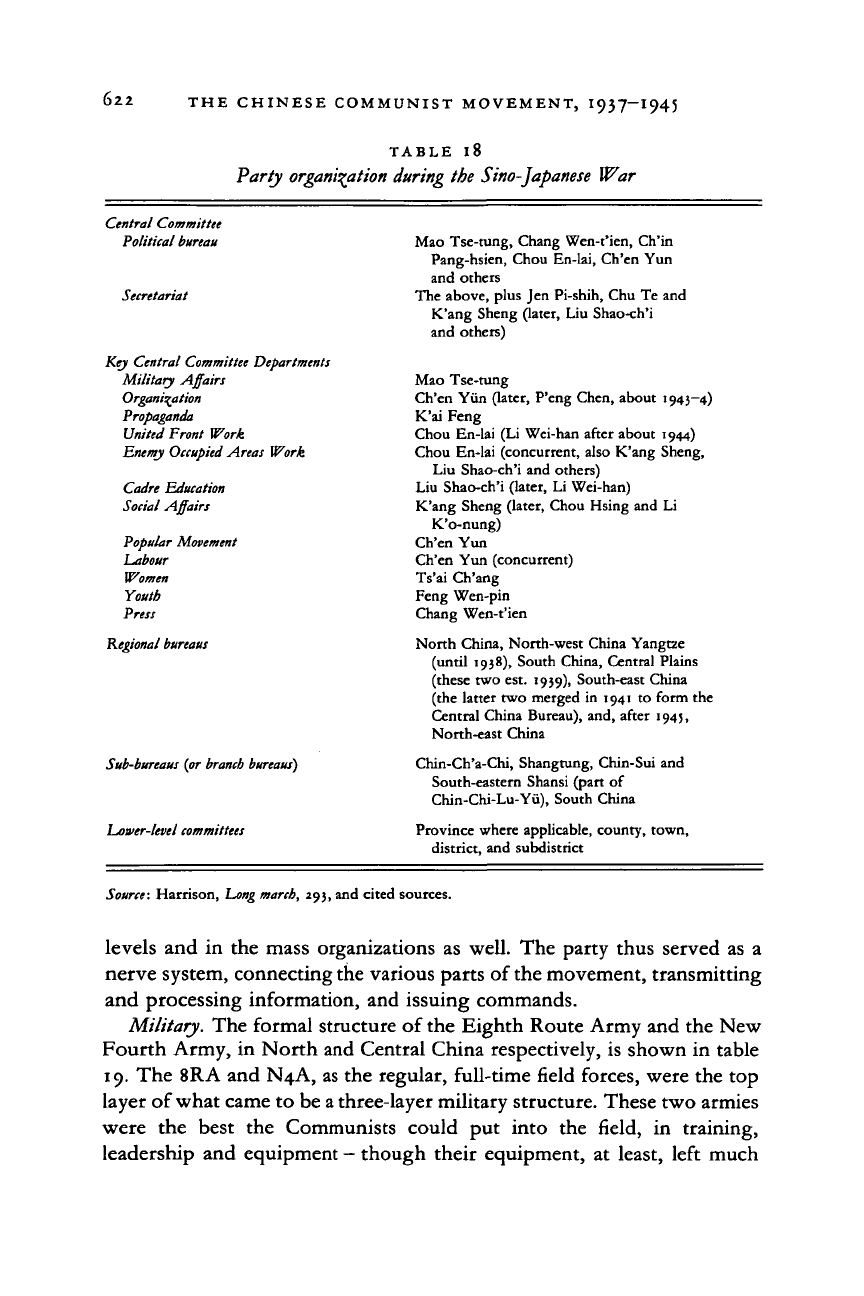
622
THE CHINESE COMMUNIST MOVEMENT, I937-I945
TABLE l8
Party
organisation
during the
Sino-Japanese
War
Central Committee
Political bureau
Secretariat
Key Central Committee Departments
Military Affairs
Organisation
Propaganda
United Front Work
Enemy Occupied Areas Work
Cadre Education
Social Affairs
Popular Movement
Labour
Women
Youth
Press
Regional
bureaus
Mao Tse-tung, Chang Wen-t'ien, Ch'in
Pang-hsien, Chou En-lai, Ch'en Yun
and others
The above, plus Jen Pi-shih, Chu Te and
K'ang Sheng (later, Liu Shao-ch'i
and others)
Mao Tse-tung
Ch'en Yun (later, P'eng Chen, about 1943-4)
K'ai Feng
Chou En-lai (Li Wei-han after about 1944)
Chou En-lai (concurrent, also K'ang Sheng,
Liu Shao-ch'i and others)
Liu Shao-ch'i (later, Li Wei-han)
K'ang Sheng (later, Chou Hsing and Li
K'o-nung)
Ch'en Yun
Ch'en Yun (concurrent)
Ts'ai Ch'ang
Feng Wen-pin
Chang Wen-t'ien
North China, North-west China Yangtze
Sub-bureaus (or
branch
bureaus)
Lower-level committees
(until 1938), South China, Central Plains
(these two est. 1939), South-east China
(the latter two merged in 1941 to form the
Central China Bureau), and, after 1945,
North-east China
Chin-Ch'a-Chi, Shangtung, Chin-Sui and
South-eastern Shansi (part of
Chin-Chi-Lu-Yu), South China
Province where applicable, county, town,
district, and subdistrict
Source:
Harrison,
Long
march,
293, and cited sources.
levels and
in
the mass organizations as well. The party thus served as
a
nerve system, connecting the various parts of the movement, transmitting
and processing information, and issuing commands.
Military. The formal structure of the Eighth Route Army and the New
Fourth Army, in North and Central China respectively, is shown in table
19.
The 8RA and N4A, as the regular, full-time field forces, were the top
layer of what came to be
a
three-layer military structure. These two armies
were
the
best
the
Communists could
put
into
the
field,
in
training,
leadership and equipment
-
though their equipment,
at
least, left much
Cambridge Histories Online © Cambridge University Press, 2008
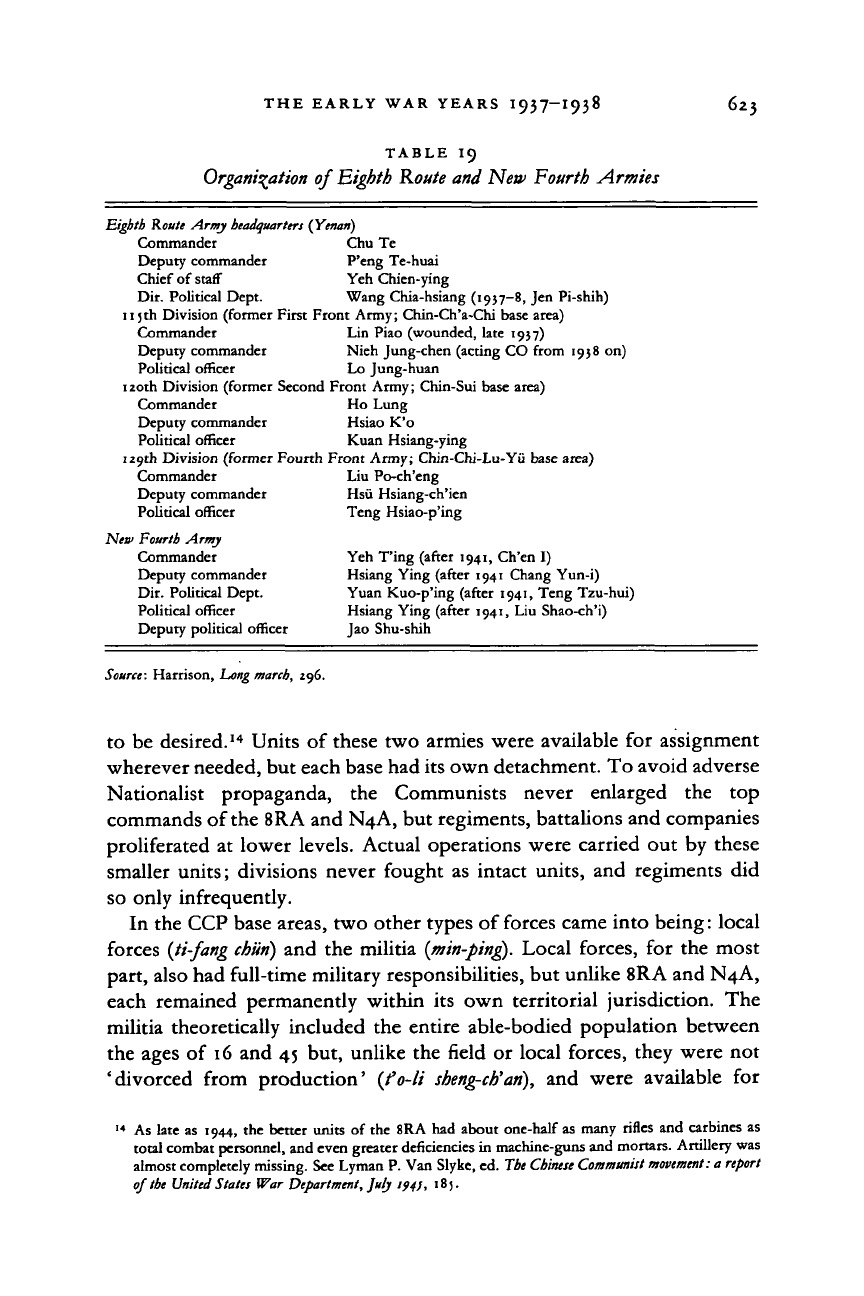
THE EARLY WAR YEARS I937—1938 623
TABLE 19
Organisation of Eighth Route and New Fourth Armies
Eighth Route Army headquarters {Yenan)
Commander Chu Te
Deputy commander P'eng Te-huai
Chief of staff Yeh Chien-ying
Dir. Political Dept. Wang Chia-hsiang (1937-8, Jen Pi-shih)
115th Division (former First Front Army; Chin-Ch'a-Chi base area)
Commander Lin Piao (wounded, late 1957)
Deputy commander Nieh Jung-chen (acting CO from 1938 on)
Political officer Lo Jung-huan
120th Division (former Second Front Army; Chin-Sui base area)
Commander Ho Lung
Deputy commander Hsiao K'o
Political officer Kuan Hsiang-ying
129th Division (former Fourth Front Army; Chin-Chi-Lu-Yii base area)
Commander Liu Po-ch'eng
Deputy commander Hsu Hsiang-ch'ien
Political officer Teng Hsiao-p'ing
New
Fourth
Army
Commander Yeh T'ing (after 1941, Ch'en I)
Deputy commander Hsiang Ying (after 1941 Chang Yun-i)
Dir. Political Dept. Yuan Kuo-p'ing (after 1941, Teng Tzu-hui)
Political officer Hsiang Ying (after 1941, Liu Shao-ch'i)
Deputy political officer Jao Shu-shih
Source: Harrison, hong march, 296.
to be desired.
14
Units of these two armies were available for assignment
wherever needed, but each base had its own detachment. To avoid adverse
Nationalist propaganda, the Communists never enlarged the top
commands of the 8RA and N4A, but regiments, battalions and companies
proliferated at lower levels. Actual operations were carried out by these
smaller units; divisions never fought as intact units, and regiments did
so only infrequently.
In the CCP base areas, two other types of forces came into being: local
forces
(ti-fang churi)
and the militia
(min-ping).
Local forces, for the most
part, also had full-time military responsibilities, but unlike 8RA and N4A,
each remained permanently within its own territorial jurisdiction. The
militia theoretically included the entire able-bodied population between
the ages of 16 and 45 but, unlike the field or local forces, they were not
'divorced from production' (fo-li
sheng-ch'an),
and were available for
14
As late as 1944, the better units of the 8RA had about one-half as many rifles and carbines as
total combat personnel, and even greater deficiencies in machine-guns and mortars. Artillery was
almost completely missing. See Lyman P. Van Slyke, ed.
The
Chinese Communist
movement:
a
report
of the United States
War
Department, July if
4),
I8J.
Cambridge Histories Online © Cambridge University Press, 2008

624 THE CHINESE COMMUNIST MOVEMENT, I937-I945
part-time duty when needed. Meanwhile they carried on their regular
occupations. Of course, deficiencies in training and equipment became
increasingly pronounced as one descended through this military structure.
The militia was armed mostly with broadswords and farm tools, their
old-fashioned bird guns and rifles
(t'u-cb'iang)
having been appropriated
for use by the field or local forces.
Although the creation of this military structure was a complex and
difficult task, with wide variation in time and place, the Communists
nevertheless gradually built up a linked hierarchy of military power
reaching downward into local society. When an element of the 8RA or
N4A entered an unfamiliar area, it could expect to work with auxiliaries
who knew the terrain and the enemy's dispositions, and with a local
population who provided logistic support, intelligence, guides and shelter.
Each level was a recruiting ground for the level above, a source of training
and replenishment of manpower. Indeed, most of the increases in the size
of the 8RA and the N4A during the last year of the war (see above, table
17) came from wholesale redesignation of local forces.
Everywhere it went, the CCP sought to reduce traditional peasant
resentment and mistrust of military service, which in folklore and bitter
experience usually meant that a beloved son or husband and his badly
needed labour were lost forever. But everyone was familiar with the idea
of
a
young man working in the fields and coming to the defence of family
and village when necessary. If some of these young men then moved on
to full-time military service in the local forces or in the regular armies,
the shock was not so great - particularly if their families were given
certain tax breaks, help with their crops, and the prestige of having
contributed to the Tzu-ti Chun ('the army of sons and brothers'). Indeed,
enlisting a son was one way that wealthier rural families sought favour
and immunity.
In public, the CCP spoke of their military forces as aroused Chinese
citizens fighting against the Japanese invaders and their traitorous
puppets. But in addition to this role, Communist-led forces at all levels
performed many other tasks, among which were contesting for territorial
control with various local rivals, enforcement of social and economic
policies, security and police functions. The Communists also had to
calculate how large a force 'divorced from production' each locality could
support, since many party and government cadres also needed to be fed
and housed through others' labour. Where ordinarily slender surpluses
were further reduced by the impact of the war, economically non-
productive personnel could easily become a crushing burden.
Coordination.
One cannot, of course, gauge the effectiveness of an
Cambridge Histories Online © Cambridge University Press, 2008
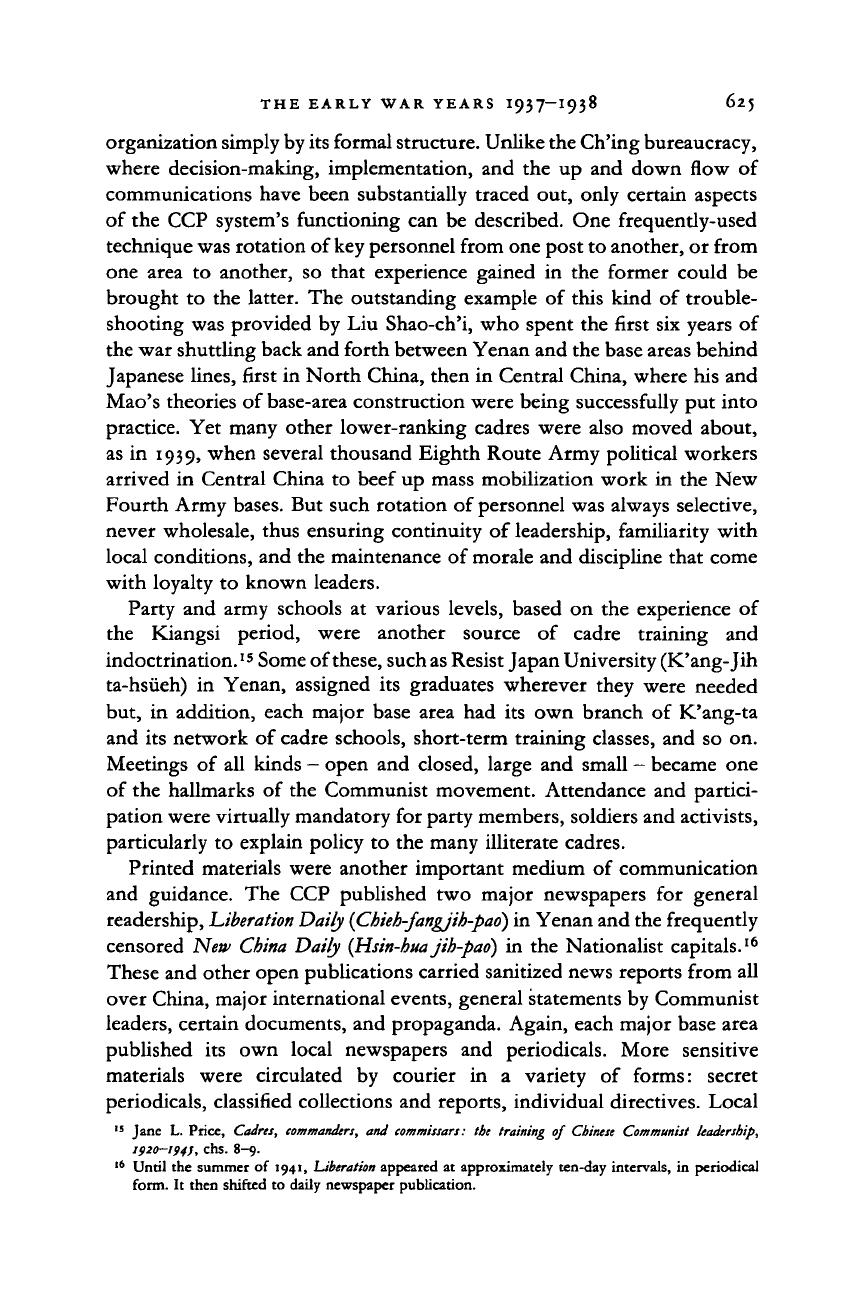
THE EARLY WAR YEARS I937—1938 625
organization simply by its formal structure. Unlike the Ch'ing bureaucracy,
where decision-making, implementation, and the up and down flow of
communications have been substantially traced out, only certain aspects
of the CCP system's functioning can be described. One frequently-used
technique was rotation of
key
personnel from one post to another, or from
one area to another, so that experience gained in the former could be
brought to the latter. The outstanding example of this kind of trouble-
shooting was provided by Liu Shao-ch'i, who spent the first six years of
the war shuttling back and forth between Yenan and the base areas behind
Japanese lines, first in North China, then in Central China, where his and
Mao's theories of base-area construction were being successfully put into
practice. Yet many other lower-ranking cadres were also moved about,
as in 1939, when several thousand Eighth Route Army political workers
arrived in Central China to beef up mass mobilization work in the New
Fourth Army bases. But such rotation of personnel was always selective,
never wholesale, thus ensuring continuity of leadership, familiarity with
local conditions, and the maintenance of morale and discipline that come
with loyalty to known leaders.
Party and army schools at various levels, based on the experience of
the Kiangsi period, were another source of cadre training and
indoctrination.
15
Some of these, such
as
Resist Japan University (K'ang-Jih
ta-hsvieh) in Yenan, assigned its graduates wherever they were needed
but, in addition, each major base area had its own branch of K'ang-ta
and its network of cadre schools, short-term training classes, and so on.
Meetings of all kinds - open and closed, large and small - became one
of the hallmarks of the Communist movement. Attendance and partici-
pation were virtually mandatory for party members, soldiers and activists,
particularly to explain policy to the many illiterate cadres.
Printed materials were another important medium of communication
and guidance. The CCP published two major newspapers for general
readership,
Liberation Daily {Chieh-fangjih-pao)
in Yenan and the frequently
censored New
China
Daily (Hsin-hua jih-pao) in the Nationalist capitals.
16
These and other open publications carried sanitized news reports from all
over China, major international events, general statements by Communist
leaders, certain documents, and propaganda. Again, each major base area
published its own local newspapers and periodicals. More sensitive
materials were circulated by courier in a variety of forms: secret
periodicals, classified collections and reports, individual directives. Local
15
Jane L. Price, Cadres, commanders, and commissars: the training of Chinese Communist leadership,
1)20-if
4},
chs. 8-9.
16
Until the summer of 1941,
Liberation
appeared at approximately ten-day intervals, in periodical
form. It then shifted to daily newspaper publication.
Cambridge Histories Online © Cambridge University Press, 2008
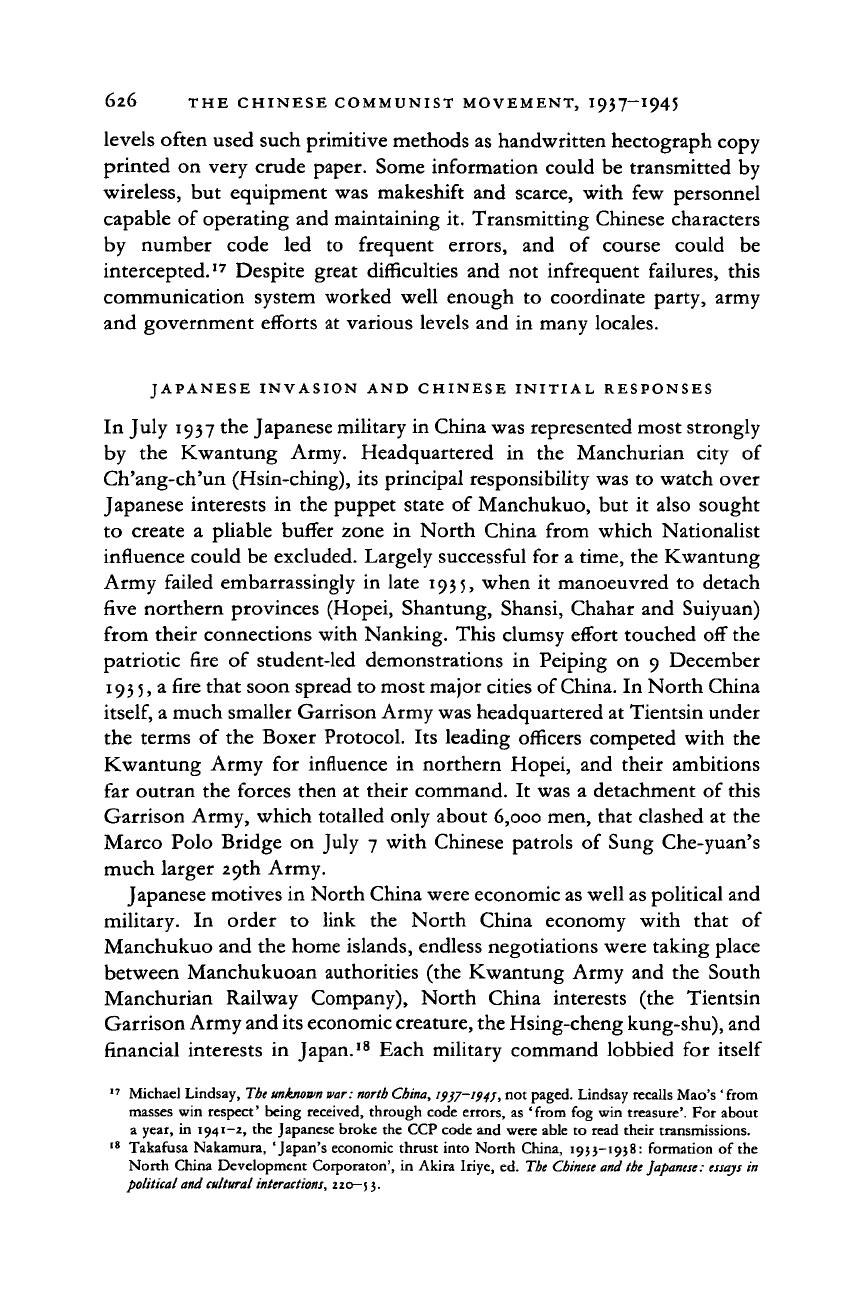
626 THE CHINESE COMMUNIST MOVEMENT, I937-1945
levels often used such primitive methods as handwritten hectograph copy
printed on very crude paper. Some information could be transmitted by
wireless, but equipment was makeshift and scarce, with few personnel
capable of operating and maintaining it. Transmitting Chinese characters
by number code
led to
frequent errors,
and of
course could
be
intercepted.
17
Despite great difficulties and not infrequent failures, this
communication system worked well enough
to
coordinate party, army
and government efforts at various levels and in many locales.
JAPANESE INVASION AND CHINESE INITIAL RESPONSES
In July 1937 the Japanese military in China was represented most strongly
by
the
Kwantung Army. Headquartered
in the
Manchurian city
of
Ch'ang-ch'un (Hsin-ching), its principal responsibility was to watch over
Japanese interests
in
the puppet state of Manchukuo, but
it
also sought
to create
a
pliable buffer zone
in
North China from which Nationalist
influence could be excluded. Largely successful for a time, the Kwantung
Army failed embarrassingly in late 1935, when
it
manoeuvred to detach
five northern provinces (Hopei, Shantung, Shansi, Chahar and Suiyuan)
from their connections with Nanking. This clumsy effort touched off the
patriotic fire
of
student-led demonstrations
in
Peiping
on 9
December
193
5,
a fire that soon spread to most major cities of
China.
In North China
itself,
a much smaller Garrison Army was headquartered at Tientsin under
the terms of the Boxer Protocol. Its leading officers competed with the
Kwantung Army
for
influence
in
northern Hopei, and their ambitions
far outran the forces then at their command.
It
was
a
detachment of this
Garrison Army, which totalled only about 6,000 men, that clashed at the
Marco Polo Bridge on July
7
with Chinese patrols
of
Sung Che-yuan's
much larger 29th Army.
Japanese motives in North China were economic as well as political and
military.
In
order
to
link
the
North China economy with that
of
Manchukuo and the home islands, endless negotiations were taking place
between Manchukuoan authorities (the Kwantung Army and the South
Manchurian Railway Company), North China interests
(the
Tientsin
Garrison Army and its economic creature, the Hsing-cheng kung-shu), and
financial interests
in
Japan.
18
Each military command lobbied for itself
17
Michael Lindsay,
The unknown
war:
north
China,
1937—194},
not paged. Lindsay recalls Mao's
*
from
masses win respect' being received, through code errors, as ' from fog win treasure'. For about
a year,
in
1941-2, the Japanese broke the CCP code and were able to read their transmissions.
18
Takafusa Nakamura, 'Japan's economic thrust into North China, 1933-1938: formation
of
the
North China Development Corporaton', in Akira Iriye, ed. The
Chinese and tbe
Japanese:
essays
in
political and cultural interactions,
220—;
3.
Cambridge Histories Online © Cambridge University Press, 2008
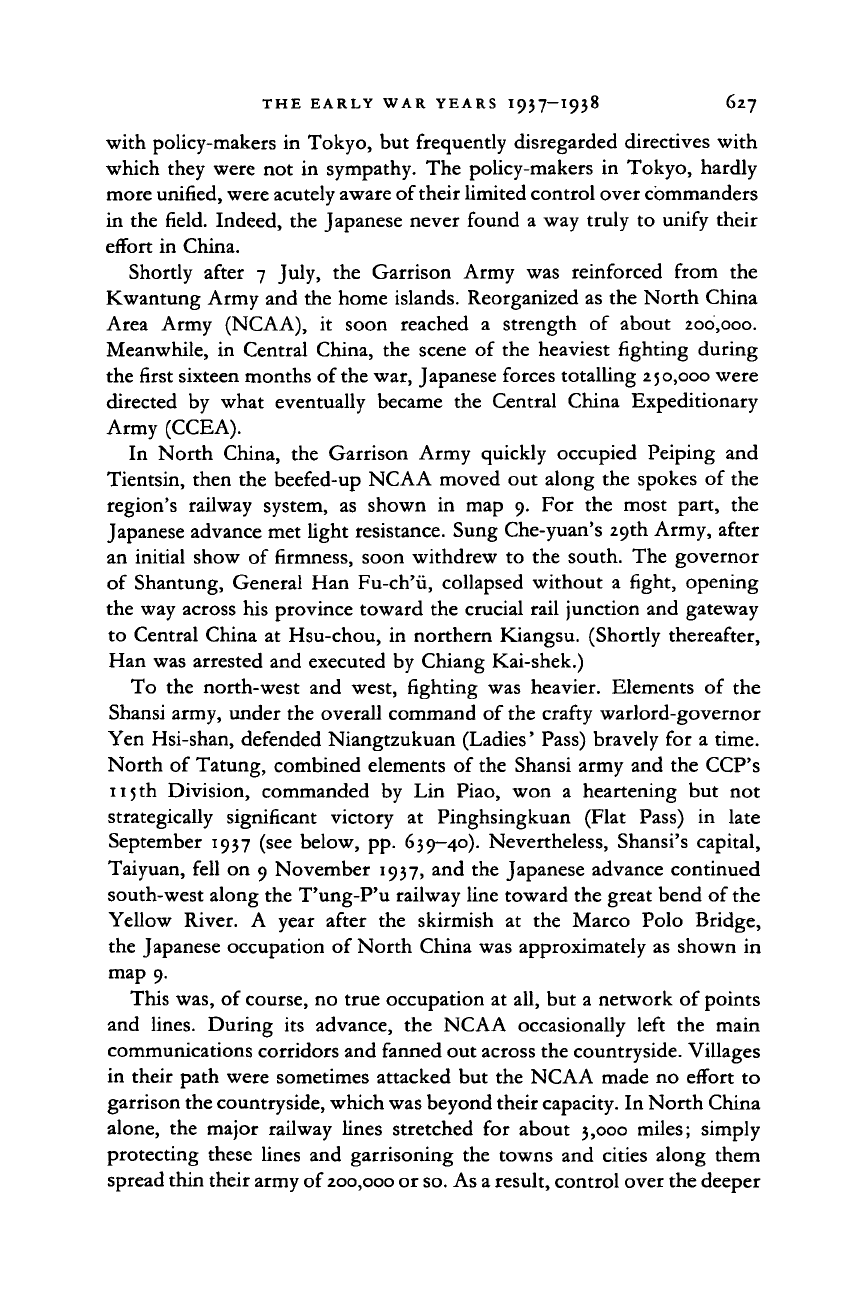
THE EARLY WAR YEARS I937—1938 627
with policy-makers in Tokyo, but frequently disregarded directives with
which they were not in sympathy. The policy-makers in Tokyo, hardly
more unified, were acutely aware of their limited control over commanders
in the field. Indeed, the Japanese never found a way truly to unify their
effort in China.
Shortly after 7 July, the Garrison Army was reinforced from the
Kwantung Army and the home islands. Reorganized as the North China
Area Army (NCAA), it soon reached a strength of about 200,000.
Meanwhile, in Central China, the scene of the heaviest fighting during
the first sixteen months of the war, Japanese forces totalling 250,000 were
directed by what eventually became the Central China Expeditionary
Army (CCEA).
In North China, the Garrison Army quickly occupied Peiping and
Tientsin, then the beefed-up NCAA moved out along the spokes of the
region's railway system, as shown in map 9. For the most part, the
Japanese advance met light resistance. Sung Che-yuan's 29th Army, after
an initial show of firmness, soon withdrew to the south. The governor
of Shantung, General Han Fu-ch'ii, collapsed without a fight, opening
the way across his province toward the crucial rail junction and gateway
to Central China at Hsu-chou, in northern Kiangsu. (Shortly thereafter,
Han was arrested and executed by Chiang Kai-shek.)
To the north-west and west, fighting was heavier. Elements of the
Shansi army, under the overall command of the crafty warlord-governor
Yen Hsi-shan, defended Niangtzukuan (Ladies' Pass) bravely for a time.
North of Tatung, combined elements of the Shansi army and the CCP's
115
th Division, commanded by Lin Piao, won a heartening but not
strategically significant victory at Pinghsingkuan (Flat Pass) in late
September 1937 (see below, pp. 639-40). Nevertheless, Shansi's capital,
Taiyuan, fell on 9 November 1937, and the Japanese advance continued
south-west along the T'ung-P'u railway line toward the great bend of the
Yellow River. A year after the skirmish at the Marco Polo Bridge,
the Japanese occupation of North China was approximately as shown in
map 9.
This was, of course, no true occupation at all, but a network of points
and lines. During its advance, the NCAA occasionally left the main
communications corridors and fanned out across the countryside. Villages
in their path were sometimes attacked but the NCAA made no effort to
garrison the countryside, which was beyond their capacity. In North China
alone, the major railway lines stretched for about 3,000 miles; simply
protecting these lines and garrisoning the towns and cities along them
spread thin their army of
200,000
or
so.
As a result, control over the deeper
Cambridge Histories Online © Cambridge University Press, 2008
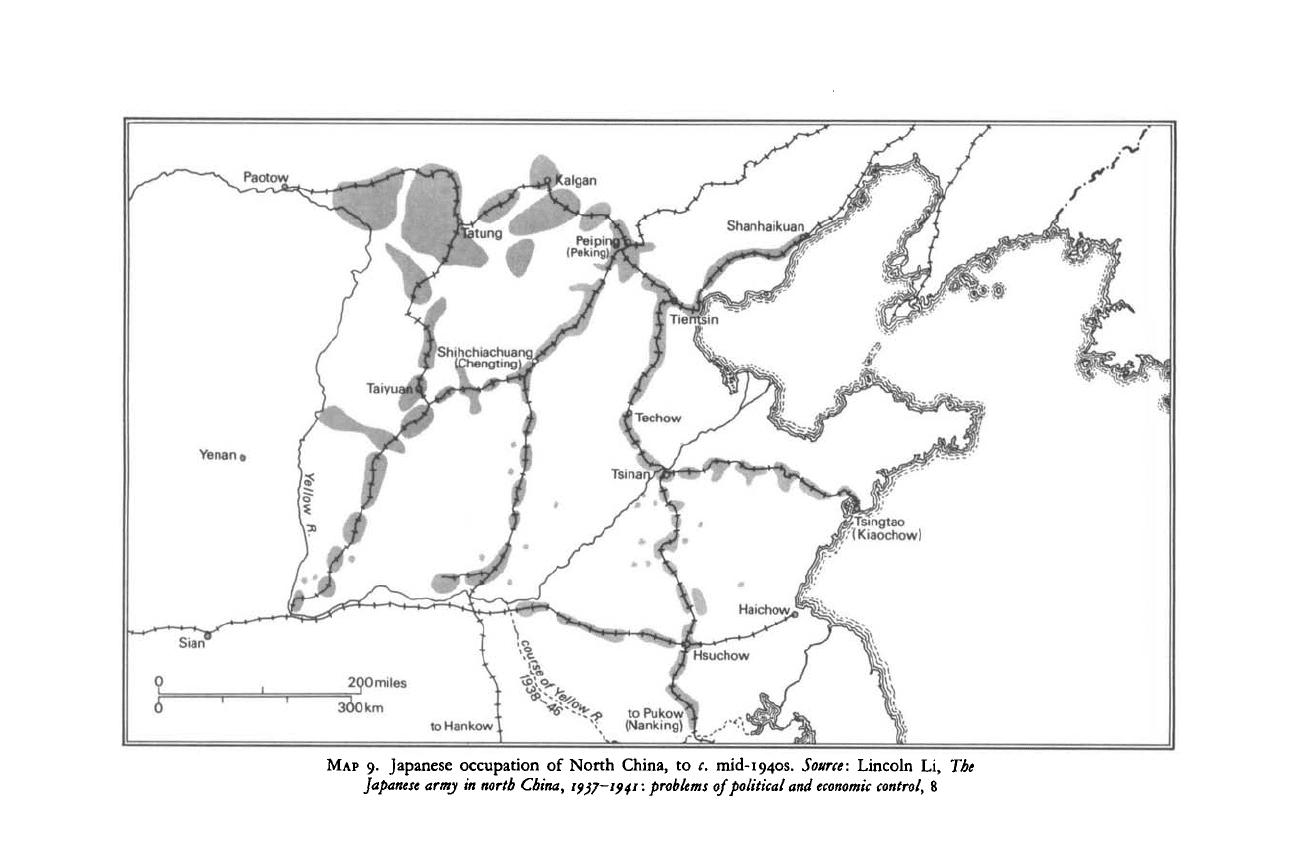
MAP
9. Japanese occupation of North China, to c. mid-io.4os.
Source:
Lincoln Li, The
Japanese army in north China, iyjf—iyji: problems of political and
economic
control,
8
Cambridge Histories Online © Cambridge University Press, 2008
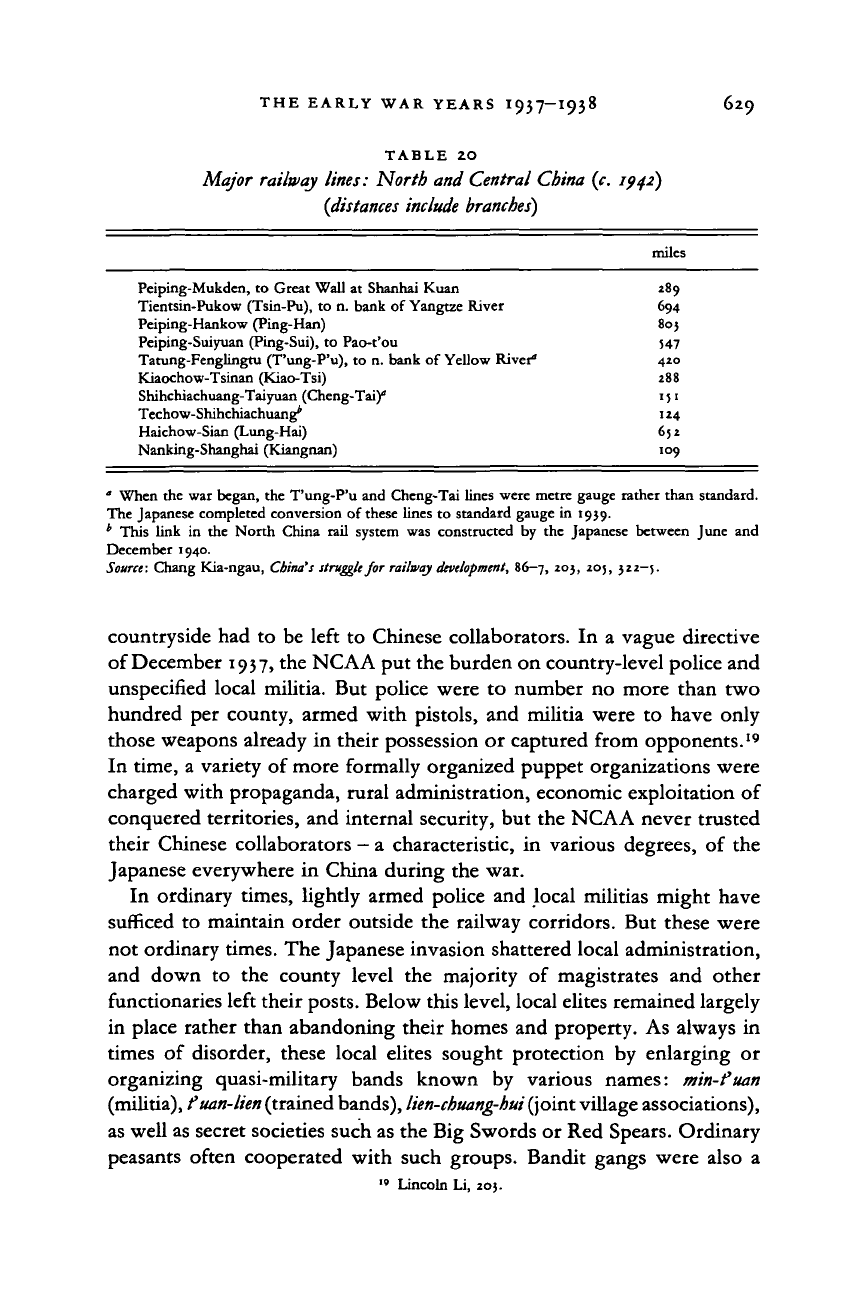
THE EARLY WAR YEARS I937-I938 629
TABLE
2O
Major railway lines: North and Central China (c. 1942)
{distances include branches)
miles
Peiping-Mukden, to Great Wall at Shanhai Kuan 289
Tientsin-Pukow (Tsin-Pu), to n. bank of Yangtze River 694
Peiping-Hankow (Ping-Han) 803
Peiping-Suiyuan (Ping-Sui), to Pao-t'ou 547
Tatung-Fenglingtu (T'ung-P'u), to n. bank of Yellow River" 420
Kiaochow-Tsinan (Kiao-Tsi) 288
Shihchiachuang-Taiyuan (Cheng-Taiy 151
Techow-Shihchiachuang* 124
Haichow-Sian (Lung-Hai) 652
Nanking-Shanghai (Kiangnan) 109
° When the war began, the T'ung-P'u and Cheng-Tai lines were metre gauge rather than standard.
The Japanese completed conversion of these lines to standard gauge in 1939.
* This link in the North China rail system was constructed by the Japanese between June and
December 1940.
Source: Chang Kia-ngau, China's struggle for railway
development,
86—7, 203, 205, 322-5.
countryside had to be left to Chinese collaborators. In a vague directive
of December 1937, the NCAA put the burden on country-level police and
unspecified local militia. But police were to number no more than two
hundred per county, armed with pistols, and militia were to have only
those weapons already in their possession or captured from opponents.
19
In time, a variety of more formally organized puppet organizations were
charged with propaganda, rural administration, economic exploitation of
conquered territories, and internal security, but the NCAA never trusted
their Chinese collaborators
—
a characteristic, in various degrees, of the
Japanese everywhere in China during the war.
In ordinary times, lightly armed police and local militias might have
sufficed to maintain order outside the railway corridors. But these were
not ordinary times. The Japanese invasion shattered local administration,
and down to the county level the majority of magistrates and other
functionaries left their posts. Below this level, local elites remained largely
in place rather than abandoning their homes and property. As always in
times of disorder, these local elites sought protection by enlarging or
organizing quasi-military bands known by various names: min-fuan
(militia),
fuan-lien
(trained bands),
lien-chuang-hui(joint
village associations),
as well as secret societies such as the Big Swords or Red Spears. Ordinary
peasants often cooperated with such groups. Bandit gangs were also a
" Lincoln Li, 203.
Cambridge Histories Online © Cambridge University Press, 2008
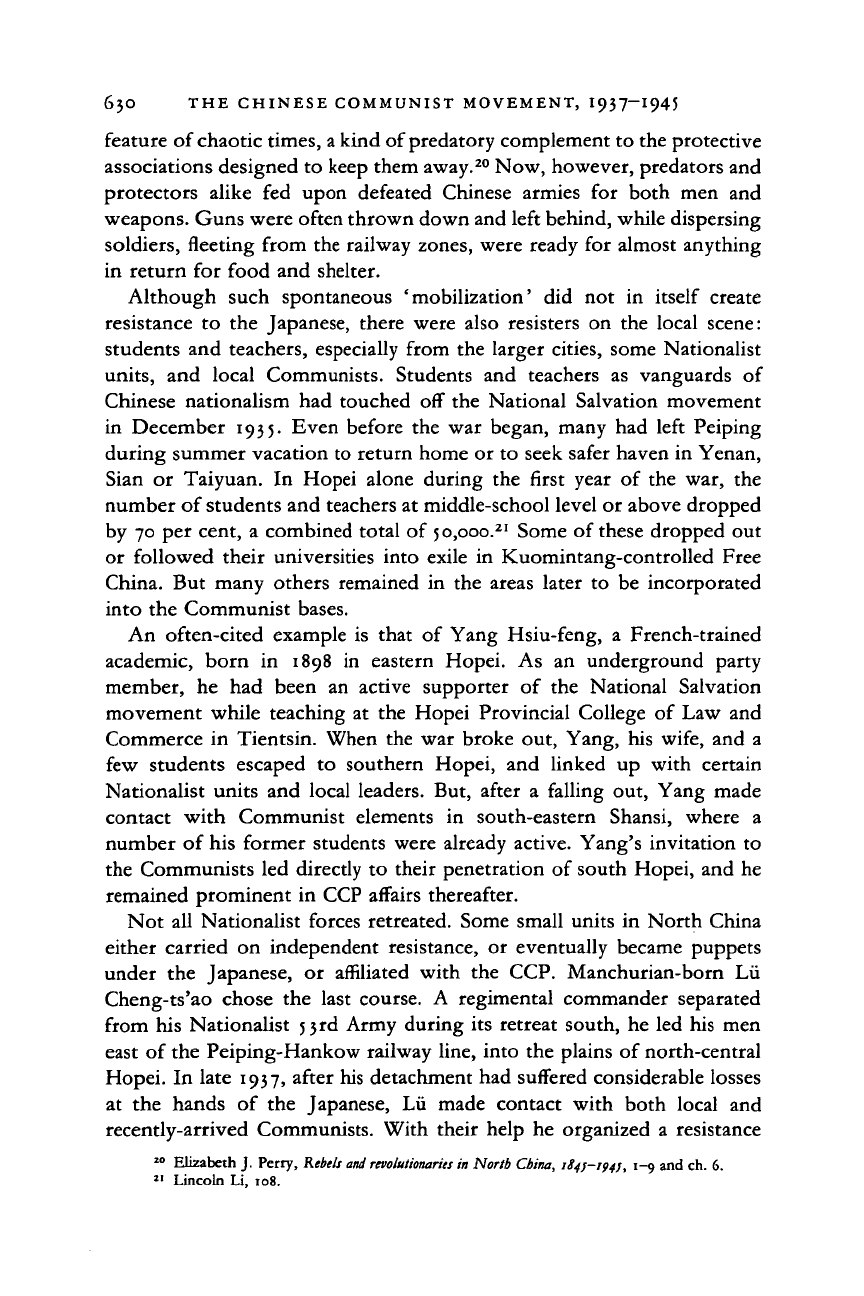
630 THE CHINESE COMMUNIST MOVEMENT, I937-1945
feature of chaotic times, a kind of predatory complement to the protective
associations designed to keep them away.
20
Now, however, predators and
protectors alike
fed
upon defeated Chinese armies
for
both men
and
weapons. Guns were often thrown down and left behind, while dispersing
soldiers, fleeting from the railway zones, were ready for almost anything
in return for food and shelter.
Although such spontaneous 'mobilization'
did not in
itself create
resistance
to
the Japanese, there were also resisters
on
the local scene:
students and teachers, especially from the larger cities, some Nationalist
units,
and
local Communists. Students
and
teachers
as
vanguards
of
Chinese nationalism had touched off the National Salvation movement
in December 1935. Even before the war began, many had left Peiping
during summer vacation to return home or to seek safer haven in Yenan,
Sian
or
Taiyuan.
In
Hopei alone during the first year
of
the war,
the
number of students and teachers at middle-school level or above dropped
by 70 per cent,
a
combined total
of
jo.ooo.
21
Some of these dropped out
or followed their universities into exile
in
Kuomintang-controlled Free
China. But many others remained
in
the areas later
to
be incorporated
into the Communist bases.
An often-cited example
is
that
of
Yang Hsiu-feng,
a
French-trained
academic, born
in
1898
in
eastern Hopei.
As an
underground party
member,
he had
been
an
active supporter
of
the National Salvation
movement while teaching
at
the Hopei Provincial College
of
Law and
Commerce
in
Tientsin. When the war broke out, Yang, his wife, and
a
few students escaped
to
southern Hopei,
and
linked
up
with certain
Nationalist units and local leaders. But, after
a
falling out, Yang made
contact with Communist elements
in
south-eastern Shansi, where
a
number of his former students were already active. Yang's invitation
to
the Communists led directly to their penetration of south Hopei, and he
remained prominent in CCP affairs thereafter.
Not all Nationalist forces retreated. Some small units
in
North China
either carried
on
independent resistance,
or
eventually became puppets
under
the
Japanese,
or
affiliated with
the
CCP. Manchurian-born
Lii
Cheng-ts'ao chose the last course.
A
regimental commander separated
from his Nationalist 53 rd Army during its retreat south, he led his men
east of the Peiping-Hankow railway line, into the plains of north-central
Hopei. In late 1937, after his detachment had suffered considerable losses
at
the
hands
of
the Japanese,
Lii
made contact with both local
and
recently-arrived Communists. With their help he organized
a
resistance
20
Elizabeth
J.
Perry, Rebels and revolutionaries in North China, ifyj-ipj),
1-9
and ch.
6.
21
Lincoln
Li,
108.
Cambridge Histories Online © Cambridge University Press, 2008
